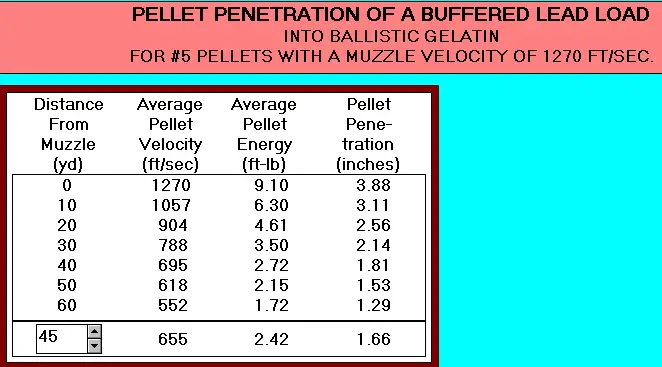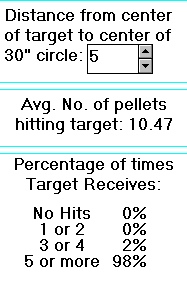


Pheasants Past Fifty Yards and Pellet Size Selection for Upland Game

Patterning a Benelli M2 20 Gauge Comfortech at 53 yards for pheasants, or "well past second base."
In the manufacturer's shotshell ammunition catalogs you likely have read a bewildering array of "preferred" shot size recommendations for game. But, shot size selection does not need to be nearly as disjointed and convoluted as it appears. Manufacturers that put patterns in their catalogs usually show both 40 yard patterns and smaller size shot, it just looks better that way. It is of no help whatsoever to you if you are taking birds that require larger shot sizes for clean kills, or if we are taking birds at 50 yards or 20 yards. Worse than meaningless, it can be downright misleading.
Heavier payloads give us the potential of larger effective spreads; there is no doubt about that. To achieve maximum effective spreads, as our shot cloud decreases in weight and pellet count, we need better pattern efficiency.
There are essentially three ranges at which birds are bagged, short (20 yards and under), medium (20 to 40 yards) and long range (40 yards and beyond). These are my own admittedly arbitrary values, but that is my experience. You probably haven't heard that "pheasants are like baseball." Well, pheasant hunting isn't like baseball, exactly, but some of the ranges involved are directly relevant.

Pheasant hunting distances are like baseball. It's roughly 20 yards from home to the pitcher's mound, 30 yards to first base, and a bit over 40 yards from home to second. That corresponds, vaguely, to the typical short, medium, and long range distances we bag birds at. To the rubber on the pitcher's mound is a skeet shot, requiring little in the way of choke. At a range beyond the distance from home to second requires far more choke effect, more attention to choke, shell, pellet penetration, and requisite time at the patterning board to ensure our effectiveness.
There are essentially three classes of upland wing-shooting game, in order of toughness: easy to kill (doves, quail, etc.), medium (pigeon, partridge and similar size), and hard (pheasant, and similar). These again are general classifications. To find the most effective combinations for our applications, we have to define the distances at which we will take the shot, and the distances at which we will not.
Doves are very easy to kill, but there is a big difference between pass-shooting at 50 yards and closer range work. Doves are mostly feathers, so we do need good pattern density to be assured of sending them spinning with certainty. Erring on the size of heavier payloads, larger shot, and tighter pattern density gives us the ability to reach out past 50 yards.
For my purposes, 1-1/8 oz. in 12 or 16 gauge, and 1 oz. in 20 gauge using #7-1/2 shot with 65% or better pattern efficiency (roughly improved modified performance) is a good compromise. And a compromise is what all shot size/load selection is, as to have the maximum effective spread at 50 yards with a shotshell necessarily means we have a smaller effective spread at 25 yards. Thousands of dead doves have proved to me that a 1 to 1-1/8 oz. payload of #7-1/2 shot and a relatively tight choke constriction reliably kills where (for example) a 7/8 oz. improved cylinder load of #8 shot fails to perform. It means many more birds in the bag.
That said, for inside 30 yards #8 shot, 7/8 oz. loads, and ten to fifteen thousands constriction chokes do quite well. Short range, relatively light flushing birds such as quail are easier to take with our maximum effective spread at closer, more appropriate, ranges. As always, patterning at the range we are taking game reveals what we are working with in any individual gun. There is no substitute for, and no way to avoid, patterning.
Pigeons and chukars are quite a bit harder to kill quickly than doves, and the classic live pigeon load of 1-1/4 oz. of #7-1/2 shot used with a "full" or "extra full" choke did not come into being by happenstance. Some experienced pigeon-poppers prefer #6 shot. Again, it is a compromise of range and where we choose to set our maximum effective pattern spread. Of course, we need to pattern once again to have any idea what our shot cloud is really doing out of an individual gun at a specific range. We need to pattern at the ranges we intend to shoot, and want a maximum effective spread at that range as shown by the pattern board.
To show how absurd some of the conventional "wisdom" has become; some of our soldier of fortune "home defense cowboys" suggests heavy buckshot loads and extra-full chokes for "home defense." If only they would bother to get some rudimentary training, or fire a 1 ounce .010 in. constriction load of #6 shot into a phonebook at 5 yards, they would quickly understand that at very close ranges shotshell patterns are not "patterns" at all, functioning as one solid glob of shot with a very small spread, even from guns with no choke constriction at all. So it goes, a story for another day.
Having the good fortune to start my shotgunning at a very early age (I owned a shotgun before I had a BB gun) and growing up on an Illinois farm, by now I have over twelve hundred wild pheasants in the meat locker. I can tell you that there is nothing better than a heavy payload of #5 shot and a 60% to 70% 40 yard pattern percentage for a good rooster load.
Consider that for years #4 lead was a standard for mallards, with generally exposed torsos. A flushing pheasant usually wants to get the heck out of Dodge, and is more inclined to show you tail feathers and his back than to give you an exposed passing shot. Though #6 shot has been used for years, #5 shot absolutely gives less runners. To have a 100% recovery rate on a pheasant, you need to break a wing and a leg. If he falls dead, so much the better, but even if he has a few seconds of life left in him he is anchored for good and can't burrow down in tall grass or move over a few corn rows.
You'll often read about #7-1/2 shot for pheasants, which is suitable only for pen raised birds in my opinion. Conversely, you'll often read #4 shot for "late season" pheasants. A good shot size, to be sure, but pheasants don't read the season dates. A smart pheasant is still a smart pheasant on opening day, smarter than a coyote, and wild flushes are common for mature, savvy roosters at any time of the season. #4 shot is good, but for long range shooting you have significantly less pellets per ounce with which to properly populate your pattern. # 4 has about 135 (2% antimony) pellets per ounce, while # 5 shot runs about 171 pellets per ounce. You'll need better than a 25% heavier payload to have the same pellet count.
A 2-3/4 in., 1-3/8 oz. 12 gauge load of hard #5 shot is fabulously effective throughout the season. To get the same pellet count with #4 shot you'll need to go to 3 inch shells to get the same maximum effective spread at the same range. According to Lyman, 1-3/8 oz. of #5 lead shot is about 234 pellets. To get there with #4 shot, we have to hit 1-3/4 oz. (236 pellets). It gets a little more complicated than that, though, if the intent is extended range. The same pellet count won't cut the mustard with the inevitable pattern thinning at 60 yards, so we need more than 1-3/4 oz. to have the same effective pattern size. With an 1150 fps 3 ft. velocity shell, we have the 1.5 inches of penetration to do the job at 60 yards. It takes the 20 gauge out of the equation based on hull capacity and now we might be considering punishing ourselves with 2 oz. three inch 12 gauge shells to do the trick. There is a shell that often does pattern well at 60 yards, Federal's buffered #4 shot 2 oz. PFC159 three inch shell. It isn't my idea of a comfy load to shoot, though, so in the case of that far out discretion is often the better part of valor, etc. I'll save the ammo, my shoulder, and go back for him another day in most cases . . . but others have their own ideas on that as well.
The lethality of a pellet (a round ball load) is often defined by energy, but more correctly it is the ability of the pellet to penetrate that counts. Energy values are easier to calculate than penetration ability, so that is why they are mentioned here, just as incorrectly as anywhere else. Let's take a peek at energy and drop at range, every bit as important in pellet selection as counting holes in paper.
#9 shot launched at 1200 fps has only about 7/10th of a ft. lb. of energy left at 40 yards; #7-1/2 has 1.3 ft. lbs., #6 2.2 ft. lbs., and #5 3.1 ft. lbs. Phrased differently, #5 shot has far more energy at 60 yards (2.2 ft. lbs.) than # 8 shot has at 20 yards (1.7 ft. lbs.). With perhaps the exception of quail, #8 or #9 shot is best left to the skeet field. #7-1/2 is reasonable for dove and other extremely fragile birds, with #6 good for medium birds at medium ranges. #6 shot performs poorly on pheasants except at short range. (You can place about as much energy per #5 shot pellet into a pheasant at 40 yards as you can with #6 shot at 20 yards.) Insufficient penetration means lost or crippled birds.
To summarize what I've experienced over the last forty years, most hunters could bag more birds more cleanly and more quickly by never using payloads less than one ounce on anything, opting for a better pattern efficiency through a combination of quality shot, shells, and chokes as proven by pattern testing in their own gun. Further, you will likely bag more birds with heavier payloads and larger shot sizes than are often recommended. You are probably a better shot than you think you are; your patterns have likely been crippling your performance.
Back to our pheasants; we want about an inch and a half of penetration into 10% ballistic gelatin for dead in the air results. With an 1185 fps three-foot velocity Federal 1-5/16 oz. buffered load of #5 shot, here's what it looks like:

Penetration is one component, but we need adequate pattern density with fairly even dispersion. Things can change drastically in concert with range, so if we want the ability to shoot at 50 yards, we have to pattern at 50 yards or so to get an idea of what we are working with.

Above is a 22 in. x 28 inch posterboad with 111 holes from #5 lead at 53 yards. It is smaller than the 30 inch circle at 40 yards that is a quasi "industry standard." When pheasants have 30 inch kill zones, I'll be more interested in 30 inch circles. If I only shot at 40 yards, then I'd be more interested in just 40 yards as well. The Birchwood Casey Shoot*N*C target is an 8 inch circle. It has 14 holes in it. Moving another 8 inch circle around our target yields similar or greater pellet counts. A 5 inch circle is more reflective of the kill zone of a pheasant, 25 square inches, but it hardly a "perfect circle." In the 5 inch circle portion above, the Trulock Precision Hunter choke and Federal 1-5/16 oz. #5 shot loads put nine pellets in the 5 inch circle. The goal of all this is essentially a 100% chance of 3-4 pellets in the kill zone at 53 yards. The 3-4 pellet in the kill zone notion, minimum, is a sound platform for most wingshooting.

With a 5 inch offset from center shot, an 80% 225 pellet pattern (30 in. circle) yields these Ed Lowry based results, above, for a 25 square inch target.
Whether we place our pattern perfectly on the bird, slightly above, below, or to the left or right we can be assured of about a dozen hits on the bird, half a dozen hits to the vitals, and that means a dead in the air pheasant. It happens to be from an M2 twenty gauge, but patterns don't care what gauge forms them and pheasants aren't nearly as fascinated with what gauge drops them as we are. It took a Trulock Precision Hunter Extended Choke of about .030 constriction to get the job done with this shell and this Benelli M2 20 gauge, the type of patttern effectiveness you won't find with a factory choke tube or a generic hunting shell. A little pre-season homework like this and the guesswork is taken out of the equation. If we want pheasant and wild rice under glass, we are better off not guessing. If we choose to guess, the dog will never forgive us.
Copyright 2006, 2010 by Randy Wakeman. All Rights Reserved.

Custom Search



